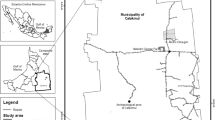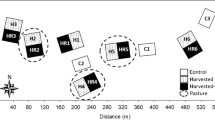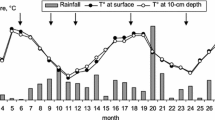Abstract
Aims
This study aimed to determine the influence of different harvest residue management strategies on tree growth, soil carbon (C) concentrations, soil nitrogen (N) availability and ecosystem C stocks 15 years after replanting second rotation Chinese fir (Cunninghamia lanceolata), an important plantation species in subtropical China. Such information is needed for designing improved management strategies for reforestation programmes in subtropical environments aimed at mitigating CO2 emissions.
Methods
Four harvest residue management treatments including slash burning, whole tree, stem-only and double residue retention were applied to sixteen 20 m × 30 m plots in a randomized complete block design with four replicates. Tree growth was measured annually and soil properties were measured at 3 year intervals over a 15 year period after re-planting.
Results
Cumulative diameter growth at age 15 years was significantly smaller in the slash burning than the whole tree and double residue harvest treatments. Hot water extractable N concentrations increased with the increased organic residue retention levels and significant differences were observed between double residue and slash burning treatments. Harvest residue management had no significant effect on the soil C concentrations to 40 cm depth. ANOVA showed that harvest residue management had no significant effect on total biomass carbon at age 15, but the plantation ecosystem (soil C at 0–40 cm depth plus forest biomass C) had significantly lower C mass in the slash burning treatment compared with whole tree, stem only harvest and double residue harvest treatments.
Conclusions
These observations suggest that organic residue retention during the harvesting could improve the growth and ecosystem C stocks of Chinese fir in second rotation forest plantations in subtropical China and highlight the importance of viewing the ecosystem as a whole when evaluating the impact of harvest residue management on C stocks.




Similar content being viewed by others
References
Berthrong ST, Jobbágy EG, Jackson RB (2009) A global meta-analysis of soil exchangeable cations, pH, carbon, and nitrogen with afforestation. Ecol Appl 19:2228–2241
Bird J, Torn M (2006) Fine roots vs. needles: a comparison of 13C and 15N dynamics in a ponderosa pine forest soil. Biogeochemistry 79:361–382
Blake GR, Hartge KH (1986) Bulk density. In: Klute A (ed) Methods of soil analysis, Part I. Physical and mineralogical methods: agronomy monograph no. 9, 2nd edn., pp 363–375
Corbeels M, McMurtrie RE, Pepper DA, Mendham DS, Grove TS, O’Connell AM (2005) Long-term changes in productivity of eucalypt plantations under different harvest residue and nitrogen management practices: a modelling analysis. For Ecol Manage 217:1–18
Curtin D, Wright CE, Beare MH, McCallum FM (2006) Hot water-extractable nitrogen as an indicator of soil nitrogen availability. Soil Sci Soc Am J 70:1512–1521
de Dieu Nzila J, Bouillet JP, Laclau JP, Ranger J (2002) The effects of slash management on nutrient cycling and tree growth in Eucalyptus plantations in the Congo. For Ecol Manage 171:209–221
Guo J, Yang Y, Chen G, **e J, Gao R, Qian W (2009) Effects of clear-cutting and slash burning on soil respiration in Chinese fir and evergreen broadleaved forests in mid-subtropical China. Plant Soil 333:249–261
Huang Z, Liao L, Wang S, Cao G (2000) Allelopathy of phenolics from decomposing stump-roots in replant Chinese fir woodland. J Chem Ecol 26:2211–2219
Huang Z, Xu Z, Blumfield T, Chen C, Bubb K (2008) Soil nitrogen mineralization and fate of (15NH4)2SO4 in field-incubated soil in a hardwood plantation of subtropical Australia: the effect of mulching. J Soils Sediments 8:389–397
Huang Z, Clinton PW, Davis MR (2011) Post-harvest residue management effects on recalcitrant carbon pools and plant biomarkers within the soil heavy fraction in Pinus radiata plantations. Soil Biol Biochem 43:404–412
Jandl R, Lindner M, Vesterdal L, Bauwens B, Baritz R, Hagedorn F, Johnson DW, Minkkinen K, Byrne KA (2007) How strongly can forest management influence soil carbon sequestration? Geoderma 137:253–268
Johnson DW (1992) Effects of forest management on soil carbon storage. Water Air Soil Poll 64:83–120
Johnson DW, Curtis PS (2001) Effects of forest management on soil C and N storage: meta analysis. For Ecol Manage 140:227–238
Jokela E, Martin T (2000) Effects of ontogeny and soil nutrient supply on production, allocation, and leaf area efficiency in loblolly and slash pine stands. Can J For Res 30:1511–1524
Jones HS, Garrett LG, Beets PN, Kimberley MO, Oliver GR (2008) Impacts of harvest residue management on soil carbon stocks in a plantation forest. Soil Sci Soc Am J 72:1621–1627
Kramer C, Trumbore S, Froberg M, Cisneros Dozal LM, Zhang D, Xu X, Santos GM, Hanson PJ (2010) Recent (4 year old) leaf litter is not a major source of microbial carbon in a temperate forest mineral soil. Soil Biol Biochem 42:1028–1037
Lee EWS, Hau BCH, Corlett RT (2005) Natural regeneration in exotic tree plantations in Hong Kong, China. For Ecol Manage 212:358–366
Ma X, Heal KV, Liu A, Jarvis PG (2007) Nutrient cycling and distribution in different-aged plantations of Chinese fir in southern China. For Ecol Manage 243:61–74
Mathers NJ, Mendham DS, O’Connell AM, Grove TS, Xu Z, Saffigna PG (2003) How does residue management impact soil organic matter composition and quality under Eucalyptus globulus plantations in southwestern Australia? For Ecol Manage 179:253–267
Mendez-Millan M, Dignac MF, Rumpel C, Rasse DP, Derenne S (2010) Molecular dynamics of shoot vs. root biomarkers in an agricultural soil estimated by natural abundance 13C labelling. Soil Biol Biochem 42:169–177
Mendham DS, O’Connell AM, Grove TS, Rance SJ (2003) Residue management effects on soil carbon and nutrient contents and growth of second rotation eucalypts. For Ecol Manage 181:357–372
Nave LE, Vance ED, Swanston CW, Curtis PS (2010) Harvest impacts on soil carbon storage in temperate forests. For Ecol Manage 259:857–866
O’Connell AM, Grove TS, Mendham DS, Rance SJ (2004) Impact of harvest residue management on soil nitrogen dynamics in Eucalyptus globulus plantations in south western Australia. Soil Biol Biochem 36:39–48
Powers RF, Andrew Scott D, Sanchez FG, Voldseth RA, Page-Dumroese D, Elioff JD, Stone DM (2005) The North American long-term soil productivity experiment: findings from the first decade of research. For Ecol Manage 20:31–50
Proe MF, Dutch J (1994) Impact of whole-tree harvesting on second-rotation growth of Sitka spruce: the first 10 years. For Ecol Manage 66:39–54
Rasse D, Rumpel C, Dignac MF (2005) Is soil carbon mostly root carbon? Mechanisms for a specific stabilization. Plant Soil 269:341–356
Sayer EJ (2006) Using experimental manipulation to assess the roles of leaf litter in the functioning of forest ecosystems. Biol Rev 81:1–31
Sayer EJ, Powers JS, Tanner EVJ (2007) Increased litterfall in tropical forests boosts the transfer of soil CO2 to the atmosphere. PLoS One 2:e1299
Schaefer DA, Feng W, Zou X (2009) Plant carbon inputs and environmental factors strongly affect soil respiration in a subtropical forest of southwestern China. Soil Biol Biochem 41:1000–1007
Sheng W, Fan S (2002) Impacts of growth and development characters of Chinese fir and its plantation on the long-term site productivity. Forest Res 15:629–636 (In Chinese)
Smith CT, Lowe AT, Skinner MF, Beets PN, Schoenholtz SH, Fang S (2000) Response of radiata pine forests to residue management and fertilisation across a fertility gradient in New Zealand. For Ecol Manage 138:203–223
Sparling G, Vojvodic-Vukovic M, Schipper LA (1998) Hot-water-soluble C as a simple measure of labile soil organic matter: the relationship with microbial biomass C. Soil Biol Biochem 30:1469–1472
SPSS (2003) SPSS 11.5 Help Manual. Chicago, Illinois: SPSS
Tutua SS, Xu ZH, Blumfield TJ, Bubb KA (2008) Long-term impacts of harvest residue management on nutrition, growth and productivity of an exotic pine plantation of sub-tropical Australia. For Ecol Manage 256:741–748
Wen Y, Wei S, Qin W (1990) Analysis on the litterfall dynamics of Chinese fir plantation and its correlation to climatic factors in North Guangxi. Acta Ecol Sin 10:367–372, In Chinese, Abstract in English
Winjum JK, Schroeder PE (1997) Forest plantations of the world: their extent, ecological attributes, and carbon storage. Agr Forest Meteorol 84:153–167
Xu J (2011) China’s new forests aren’t as green as they seem. Nature 477:371
Yanai RD, Currie WS, Goodale CL (2003) Soil carbon dynamics after forest harvest: an ecosystem paradigm reconsidered. Ecosystems 6:197–212
Ying JH, He ZM, Fan SH, Su HQ, Lian HS (2001) Research on biomass and its distribution of a 29-year-old first rotation Chinese fir plantation. J Fujian College For 21:339–342, In Chinese, Abstract in English
Zhang Q (1997) Effects of soil extracts from repeated plantation woodland of Chinese-fir on microbial activities and soil nitrogen mineralization dynamics. Plant Soil 191:205–212
Acknowledgments
We thank Mr. XQ Wen and XJ Yang in the **ayang forest farm for assistance in the field. The research was supported by 2011 Program for New Century Excellent Talents in University of Ministry of Education of China and Science Foundation of the Fujian Province, China (2060203). Thanks also to Mr. Murray Davis from Scion Research in New Zealand for his helpful comments and suggestions and to Mr. HD Zeng for digitizing the map of experimental site.
Author information
Authors and Affiliations
Corresponding authors
Additional information
Responsible Editor: Johan Six.
Rights and permissions
About this article
Cite this article
Huang, Z., He, Z., Wan, X. et al. Harvest residue management effects on tree growth and ecosystem carbon in a Chinese fir plantation in subtropical China. Plant Soil 364, 303–314 (2013). https://doi.org/10.1007/s11104-012-1341-1
Received:
Accepted:
Published:
Issue Date:
DOI: https://doi.org/10.1007/s11104-012-1341-1




